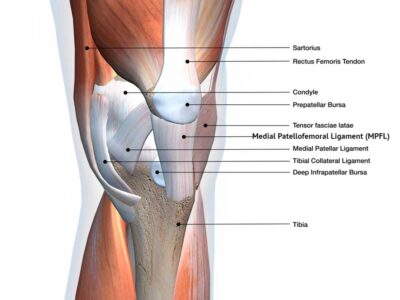Medial Patellofemoral Ligament (MPFL) Injury Specialist

Are you an athlete who participates in sports that involve pivoting such as football, racquetball, tennis and basketball? If so, you may be at risk of sustaining an MPFL injury. When the patella dislocates, it tears the MPFL structure on the inside of the knee which leads to recurrent patellar instability. Medial Patellofemoral Ligament (MPFL) Injury Specialist, Doctor Riley J. Williams provides diagnosis as well as surgical and nonsurgical treatment options for patients in Manhattan, Brooklyn, New York City and surrounding areas who are experiencing symptoms of patellar malalignment and entrapment. Contact Dr. Williams’ team today!
What is a medial patellofemoral ligament injury?
The medial patellofemoral ligament (MPFL) is part of the network of soft tissue restraints that helps stabilize the knee. The MPFL keeps the patella (kneecap) centered, such that it glides properly during leg movement. The MPFL is located on the inner side of the knee and connects the patella to the femur (thighbone). An injury, such as a sprain or tear, to this ligament often occurs because of a forceful, traumatic patella dislocation. MPFL injuries are more common in females and athletes. Dr. Riley J. Williams, orthopedic knee specialist serving Manhattan, Brooklyn, New York City, NY and surrounding areas has extensive experience in treating a medial patellofemoral ligament injury, MPFL tear, MPFL insufficiency and other knee related injuries.
What is an MPFL tear?
The patella rests in a groove in the front of the distal femur called the trochlear. The articulation between the kneecap and trochlea facilitates normal knee movement. The natural depth of the trochlea and the MFPL help keep the patella centered in the trochlea. The patella can dislocate out of the groove due to traumatic force or an unnatural twist. The MPFL is a natural restraint against abnormal lateral movement of the patella out of the trochlea groove. During a patella dislocation, the kneecap moves laterally (outward) relative to the femur. This phenomenon is associated with a stretching or tearing of the MPFL. An individual who sustains this injury will feel acute pain and immediate swelling. The patella may lock in place. Occasionally, a dislocated kneecap may need a doctor to assist with putting the bone back in place. Most kneecap dislocations go back into place naturally. As part of the recovery process, a brace, rest and physical therapy may heal an MPFL tear.
What is MPFL insufficiency?
MPFL insufficiency is the result of an injury to the medial patellofemoral ligament. It is a chronic state where the medial patellofemoral ligament does not function properly because of the injury, such as a knee dislocation, or sustained trauma. MPFL insufficiency or incompetent MPFL can lead to repeated patellar dislocations, pain, stiffness and limited range of motion.
What are the symptoms of a medial patellofemoral ligament injury?
Individuals in the New York area who experience an MPFL injury often report the following symptoms:
- Deformation of the knee / visibly dislocated kneecap
- Buckling of the knee
- Catching in the knee while bending or straightening the leg
- Patella pain especially after activity
- Stiffness
- Swelling
- Crackling sounds (crepitus)
- Knee pain when sitting
How is a medial patellofemoral ligament injury diagnosed?
Dr. Williams will ask questions regarding your medical history, symptoms, and activities in which you participate. He will also want to know if there was a specific event that caused the knee pain such as a knee dislocation. He will perform a thorough examination of the knee. An injury to the MPFL is a soft tissue injury, as such an MRI will be ordered to provide diagnostic images of the injured knee. Dr. Williams may also order an x-ray to aid in diagnosing concomitant injuries to bone(s).
What are the treatment options available?
Non-surgical treatment:
Conservative treatment is typically the first-line course of action for an MPFL injury. The presence of loose bodies, cartilage-bone fragments, or cartilage injuries can complicate MPFL injuries and require surgical intervention. The focus of nonoperative therapy is the restoration of normal knee kinematics. Treatments should facilitate the resolution of joint swelling using rest, NSAIDs (non-steroidal anti-inflammatories), and icing. Physical therapy is often helpful in the recovering from MPFL injuries. PT exercises will help strengthen the weakened knee, and aid in the patient’s functional return.
Surgical treatment:
Surgery repair of the MPFL may be necessary in cases where nonoperative treatment fails. Surgery if often needed for the remove loose cartilage-bone fragments, repairing cartilage lesions or to repair the MPFL. Dr. Williams will use small incisions to perform arthroscopic surgery to repair or reconstruct the ligament. Arthroscopic surgery procedures use a small, narrow tube that is attached to a fiber-optic camera; the camera is carefully inserted in a small incision for visualization of the knee structures. The images are projected on a high-definition screen, allowing Dr. Williams to perform this minimally invasive procedure. Dr. Williams will repair the MPFL or use a tissue graft to reconstruct the injured ligament. Once the surgery is completed, the knee will need to be immobilized for a short period of time before physical therapy will be required. A complete return to athletic activities can happen in as little as 4-6 months following MPFL repair.
For more information on a medial patellofemoral ligament injury, MPFL tear, MPFL insufficiency and the treatment options available, please contact the office of Riley J. Williams, MD, orthopedic knee specialist serving Manhattan, Brooklyn, New York City, NY and surrounding areas.
Locations
610 W 58th Street
New York, NY 10019
148 39th Street, 7th Floor
Brooklyn, NY 11232




